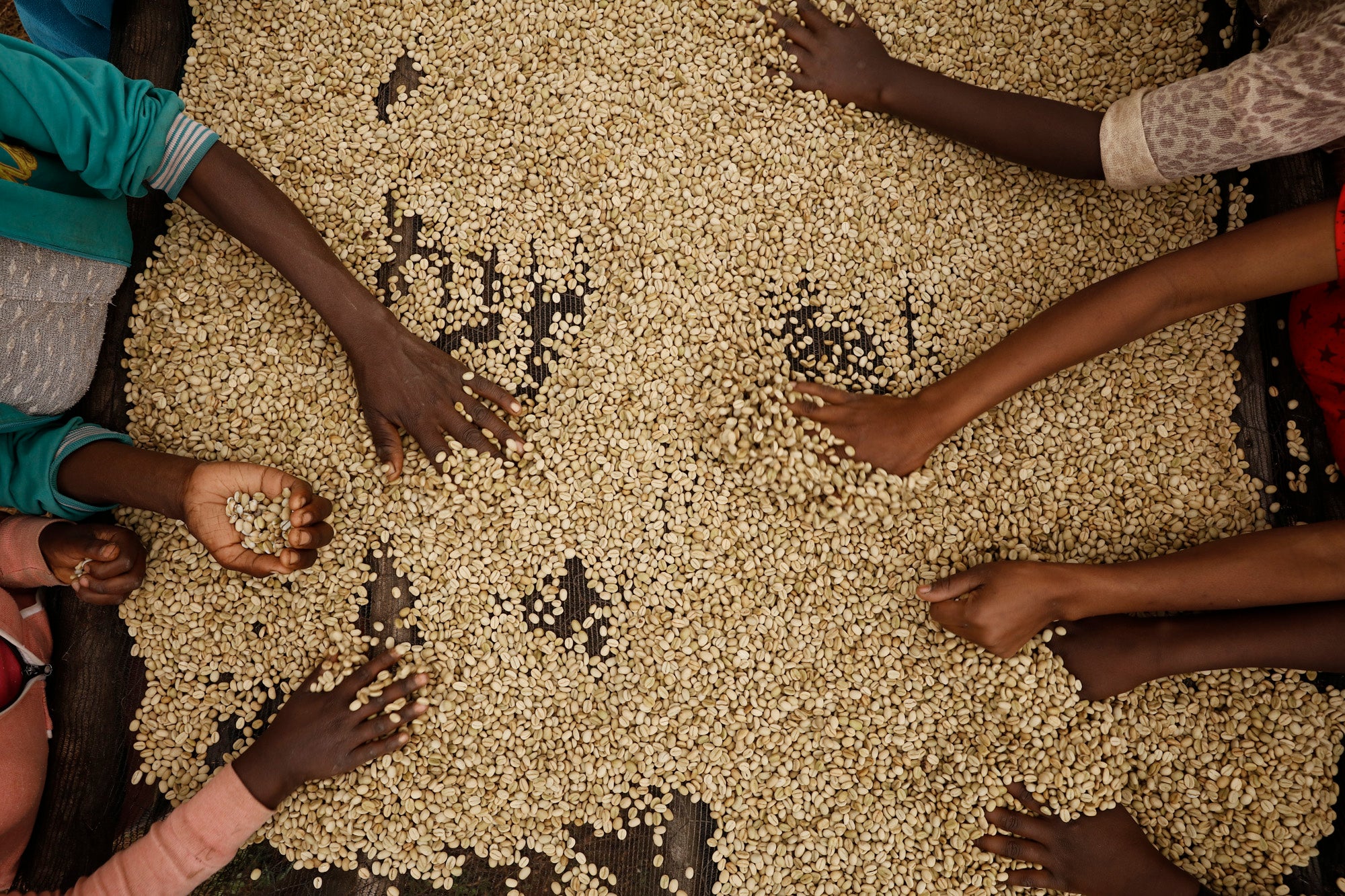Kamwangi
 Plats: Gichugu-divisionen, Kirinyaga-distriktet, Kenya
Plats: Gichugu-divisionen, Kirinyaga-distriktet, Kenya
Kooperativ: New Ngariama Cooperative Society
Tvättstation: Kamwangi fabrik
Elevation: 1600 - 1800 meter över havet
Sorter: SL28, SL34, Ruiru 11
Köpt sedan: 2011
Det här kaffet är välbekant för dig som har druckit Drop i flera år, och det är det vår favorit kenyanskt kaffe. Kamwangi är en av två fabriker som drivs av New Ngariama Cooperative i Kirinyaga i centrala Kenya. Regionernas odlingsvillkor och de många timmarna av att sortera kaffet noggrant är den främsta anledningen till att Kamwangi har hög kvalitet och gnistrande smakprofil. AA-valet är skördens största bönstorlek och ger kaffet en mer uttalad och intensifierades smak.
I Kenya kallas processstationerna, eller även kallade våtkvarnar, för fabriker. Kamwangi-fabriken är en av två fabriker under kooperativet som heter New Ngariama Cooperative Society som ligger i regionen Kirinyaga i kullarna som omger berget Kenya, med en tredje fabrik som snart kommer att tas i drift. Detta område är mindre känt än sin granne Nyeri men har överraskat oss från början med några enastående och minnesvärda kaffe.
New Ngariama Cooperative Society består huvudsakligen av små gårdar, var och en med runt 100 träd. I den Gichugu-avdelningen av Kirinyaga-distriktet där de omgivande gårdarna till Kamwangi ligger, skörden börjar i början av november. Bönderna är organiserade i Cooperative Societies som fungerar som paraplyorganisationer för Kamwangi och deras andra kooperativ, där småbrukarna levererar sina kaffekörsbär för förädling färska varje dag efter plockning under en period av cirka två månader, normalt levererar cirka 25-50 kilo till fots eller på cykel under några kilometer. När de kommer till fabriken kommer varje producent att sortera sina körsbär manuellt för att separera defekt och lägre kvalitet eftersom de får mer betalt i förhållande till kvalitet.
En del av det som gör den kenyanska smakprofilen så unik uppnås genom det mycket kontrollerade sättet att sortera och bearbeta den. Noggrann sortering görs i varje steg av bearbetningen, vilket skapar en extremt konsekvent slutprodukt. När körsbären väl har levererats till fabriken och har sorterats för över och under mogna körsbär, avmassas de i allmänhet direkt av en stor 4-diskad pulper, som tar bort körsbäret från kaffebönan.
Denna pulper fungerar också som nästa steg i sorteringen, eftersom bönorna med låg densitet flyter till toppen av vattenkanalerna efter att massan har avlägsnats och sköljs ner i en separat jäsningstank från de tätare bönorna av högre kvalitet. När de väl har avmassats jäser de i stora betongtankar över natten, vilket bryter ner det sockerhaltiga lagret (slem) så att det lätt kan tas bort under tvättprocessen. Jäsningen tar cirka 24-36 timmar, beroende på temperaturen.
Fabrikschefen kollar om kaffet har jäst färdigt genom att gnugga det mellan händerna: om det finns nötning så har slemmet försämrats tillräckligt och kaffet kan tvättas vidare, längs linjen till tvättkanalerna. Om det tillåts jäsa ytterligare, de ömtåliga smakegenskaperna skulle förstöras så tvättning måste ske vid en mycket speciell tidpunkt för att stoppa jäsningsprocessen.
De kaffe tvättas i färskt vatten för att avlägsna restsocker från slemmet och är sedan sorteras efter densitet.Bönor med lägre densitet separeras återigen för att säljas som kaffe av lägre kvalitet medan den högre densiteten bönor hålls tillbaka av grindar i kanalerna medan arbetare sveper längs kanalerna med paddlar för att flytta kaffet. När tvättprocessen är klar flyttas kaffet till torkbäddar för att sänka fukthalten till en stabil nivå innan förvaring.
Under dygnets varmaste timmar täcks kaffet för att skydda bönorna från för mycket solsken (som kan skada bönorna) och för att hålla torktiden längre. Om torkbäddarna är fulla, lagras kaffet av högre kvalitet ofta över natten i tankar med rent vatten för att förhindra ytterligare jäsning i väntan på att flyttas till torkborden. På torkborden sorteras kaffet och rörs om för hand för att säkerställa en jämn torkning, tills fukthalten når 13% sedan flyttas det till konditionerade kärl för förvaring där de tappar ca 1,5% mer. Bönorna är graderade efter bönstorlek där AA är sikt 17/18. AB är skärm 15/16 med en tolerans på 10 % under skärm 15.
De senaste åren har Kenyas kaffeproduktion kämpat mycket med kaffebärssjuka (CBD) och tuffa väderförhållanden på grund av klimatförändringar. Detta har lett till att fler planterar sorten Batian som är mer motståndskraftig än SL28 och SL34 till exempel. Batian-växten är dock inte alltid lika hög i syra eller lika intensiv som det kenyanska kaffet vi har haft det senaste decenniet som kenyanskt kaffe har varit känt för. Marken och vädret förändras på grund av klimatförändringar
När chefen Edwin Gichori besöker Kamwangi-fabriken talar han snabbt om det arbete som görs på fabriken för att bidra till att höja kvalitetsnivåerna och om var förändringar kan göras på lång sikt.
Kamwangi ger en liten förskottsbetalning till bönderna vid leverans. Vissa välskötta våtbruk kan ge mer än 85 % av försäljningspriset tillbaka till bönderna; Kamwangi kan i allmänhet ge tillbaka 80 % efter avdrag för kostnaden för fräsning och marknadsföring.
Registrerad 1997, Kamwangi är Rainforest Alliance-certifierad och har en bra struktur för att spåra betalningar till producenter. De har även etablerade blötgropar för rening av avloppsvatten samt bra kvalitetskontrollsystem för bearbetning.
